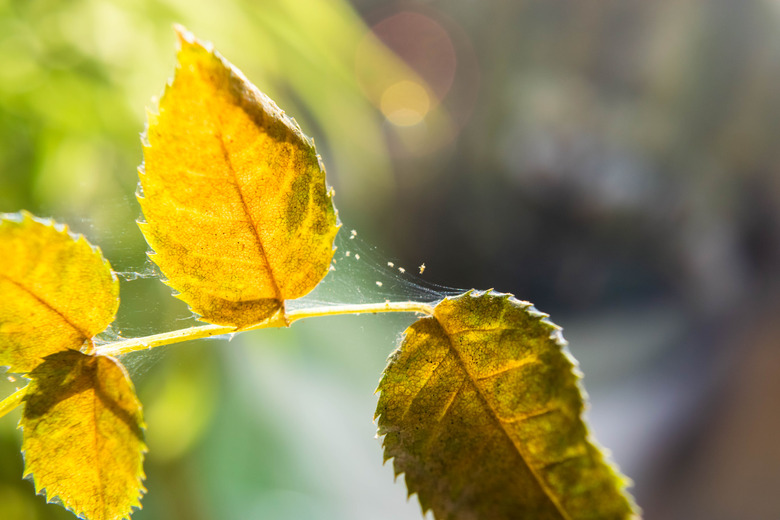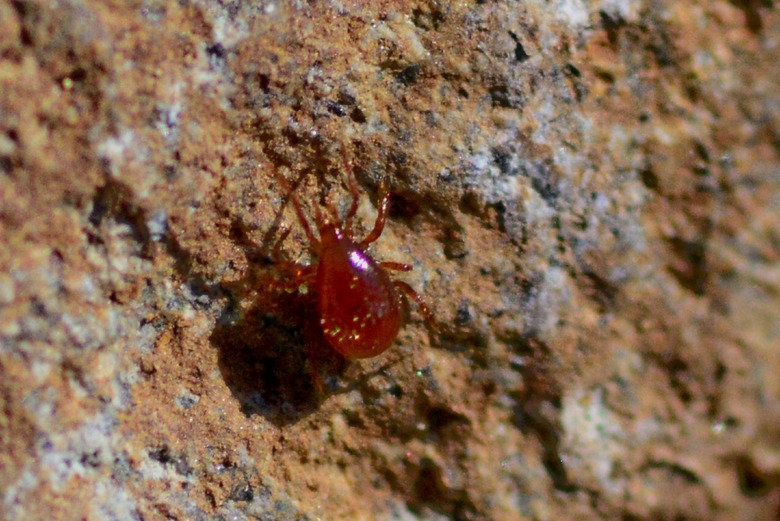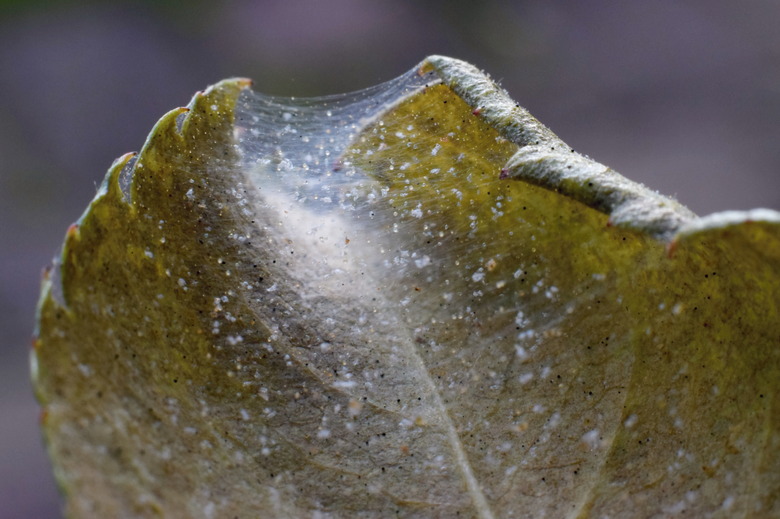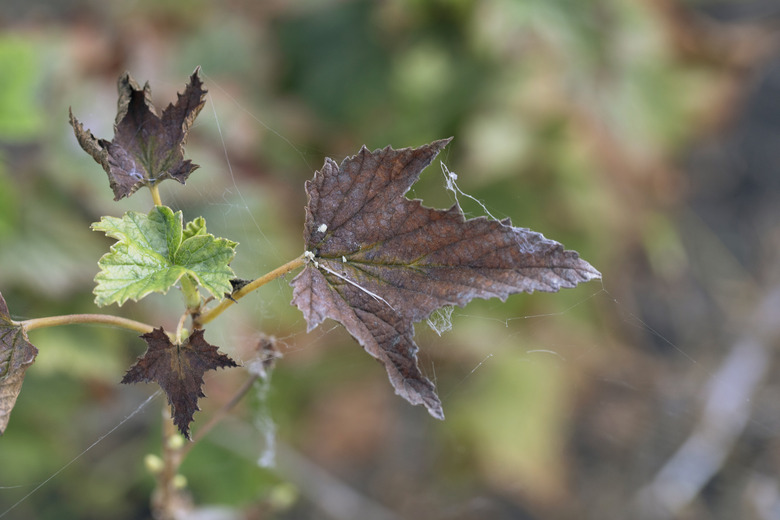How To Get Rid Of Spider Mites
We may receive a commission on purchases made from links.
Most people don't realize they have a spider mite (Tetranychus spp.) problem until the damage is severe enough to become noticeable on one of their plants. It's difficult to spot them because spider mites are nearly microscopic — only about 1/20 of an inch long — making them difficult to see without a magnifying glass. They tend to congregate on the underside of leaves, so unless you are actually looking for them, you may not even realize they are there until you see signs of damage to your plants.
So, how do they damage exactly? Spider mites pierce the leaves of plants and trees and the needles of evergreen trees to suck and feed on the sap. The feeding can kill leaves and sometimes entire plants. In severe infestations, the critters will weave webs over the leaves and stems of the plant, hence the name "spider mites."
Technically, these little pests are not insects but arachnids, and they are related to spiders and ticks. They will feed on over 200 species of plants, and nothing is out of bounds, including vegetables, berries, fruits, ornamental flowers, shrubs, trees, and even houseplants. They like hot, dry conditions, and the warm summer months are when they are most active.
Most experts recommend natural remedies to control spider mite populations — usually a combination of beneficial insects and growing conditions that discourage spider mites. In fact, the use of chemicals can often be ineffective. Pesticides can help eliminate spider mites, but they also kill off the natural predators of spider mites, which could lead to more problems in the future. Most commercial pesticides are only effective on adults, leaving the eggs unharmed. Spider mites are also known to develop resistance to chemical treatments.
What Do Spider Mites Look Like?
What Do Spider Mites Look Like?
- Species name: Tetranychus spp. There are many species, but the most common is the two-spotted spider mite (Tetranychus urciae). Common names include web-spinning spider mites, red spider mite, and strawberry spider mite.
- Physical characteristics: They are the size of pinpricks, about 1/50 to 1/20 of an inch. Colors range from red to yellow to brown. Spider mite adults have eight legs, while immature mites have six. Two-spotted spider mites have two dark spots on their back.
- Wings or wingless? They are wingless, but they have the ability to ride wind currents from plant to plant.
- Life cycle and appearance: Spider mites hatch from eggs that are laid directly on leaves and can become mature adults in as little as a week during warm weather. A mature female can lay about a dozen eggs daily for a few weeks. The eggs are translucent and remain after the mite hatches.
How to Get Rid of Spider Mites
How to Get Rid of Spider Mites
Most spider mites thrive in hot, dry, and dusty conditions. The dust helps hide eggs before they hatch. There are some species that prefer the cooler temperatures of spring and fall. A few spider mites on your plants isn't cause for alarm because they can be eliminated easily, but a large infestation is problematic. The fact that females are prolific egg layers can lead to infestations quickly.
If the problem is serious, such as the presence of webbing, which indicates an infestation, consult your county extension office for advice. It may be able to recommend a miticide that is effective against the spider mite species with which you are dealing.
No matter which type of treatment you choose, remove all leaves and sometimes whole plants that are suffering from spider mite damage. They won't get better. Bag the material and throw it in the garbage. Don't try to compost damaged plant material because it will only spread the problem.
Douse Your Plants
Spraying the underside of the leaves of outdoor plants with a garden hose can dislodge spider mites. Repeat the process every three to five days until all signs are gone. The spray will get rid of webs if they are present, and it will remove dust from the leaves.
For indoor plants, use a spray bottle filled with water to wet the plants. Follow the spritzing by wiping the underside of the leaves with a damp cloth. If you are treating a number of plants, rinse the cloth often so that you are not transferring mites from one plant to another. Repeat the process every few days.
Use Plant-Safe Treatments
You can rid plants of spider mites by using eco-friendly solutions, such as applying insecticidal soap or neem oil to plants. These are products that can eliminate mites and are safe around people, pets, and other plants.
Neem oil can also serve as a repellent to help keep spider mites away. Follow the manufacturer's directions regarding application. Usually, repeat treatments are necessary.
Introduce Spider Mite Enemies
There are a number of natural enemies of spider mites, and introducing them to your garden can help control the pest population. You can purchase predatory mites and lacewings, but the best option is to attract these predators naturally by planting things they like to much on.
Get advice on which predators to try to persuade into your garden from a garden center or from your county's extension office. Some predators feed on eggs, others feed on the larvae of mites, and some prefer adult mites. But, be aware that some predators will begin to feed on plants when there are no spider mites, although most are harmless to plants and will move to another location if mites are not available.
Chemical Treatment of Spider Mites
Using pesticides or miticides to rid a garden of spider mites can create more problems than they solve. Insecticides also kill the natural predators of spider mites. In some cases, spider mites first appear after the area has been sprayed with insecticides that eliminate the mite's natural enemies.
Spider mites can also develop resistance to some chemicals. Even if the treatment is effective now, it may not be in the future. However, there are pesticides available that reportedly kill spider mites and may be worth a try if other mitigation methods fail. Using them sparingly and targeting them only to a few plants can avoid harming beneficial insects in the rest of the garden. If you use them, be sure to follow the directions on the product.
How Do Spider Mites Get in Your House?
How Do Spider Mites Get in Your House?
Spider mites can enter your home if you bring garden plants inside or when you purchase plants, including houseplants. Inspect all plants carefully, even new ones from the garden center. Check the underside of the leaves and if you spot spider mite signs, deal with the problem by removing them with water or insecticidal soap before bringing the plant indoors or transplanting to your garden. Double-check the affected plants a few days later to make sure you eliminated the mites.
It is helpful to use a magnifying glass to examine plants. A glass with 10-times magnification that you can keep with your garden tools will work fine. You can also hold a sheet of white paper or white cardboard under the leaves and shake the leaves. The spider mites will fall off and should be visible against the white background.
Depending on the species, spider mites overwinter as adults in the cracks in tree bark or where they are protected by garden debris. Some spider mite species overwinter as eggs. Once the warm weather hits, the feeding begins.
These pests can produce multiple generations over the course of a growing season. They thrive in hot, dry weather and dusty conditions. In most places, spider mite activity dies down with cool temperatures, but in very hot climates, spider mites can reproduce and feed all year.
The warm, dry conditions of a heated home can keep spider mites alive year-round. They like very high temperatures, but they can survive in interior temperatures that humans find comfortable during the winter.
How to Prevent Spider Mites
How to Prevent Spider Mites
Preventing spider mites from gaining a foothold in your garden or home in the first place may be the best way to deal with these pests. The first step is to deprive them of the conditions in which they thrive. They like hot weather, which you can't do anything about, but they also like dry conditions.
Make sure plants are well-watered, especially during periods of little rain as spider mite activity seems to increase during drought conditions. In fact, spider mite damage is often misdiagnosed as plant stress from lack of water. Set up a regular watering schedule and maintain mulch around plants to reduce evaporation from the soil. Inside, mist and wipe down houseplants frequently and consider increasing the humidity in rooms where plants are located.
Vigilance is key to preventing spider mites. Inspect house and garden plants frequently, especially plants that were once thriving but now seem a little off or not as vibrant. This often happens before the leaves become spotted or change color.
Outside, pay attention to plants that are growing in dusty areas, such as near a road. Clean off any dust you notice on plant leaves. Use a hose on outdoor plants, dousing them in the early morning so that leaves can dry quickly. Besides cleaning off the plants and dislodging spider mites, the early watering gives the plants the resources to withstand the heat of the day, and less water is lost to evaporation.
Signs of Spider Mite Damage
Signs of Spider Mite Damage
Spider mite feeding first shows up as tiny white, yellow, or brown spots. From there, the leaves can take on a stippled appearance. In some cases, the entire leaf will turn yellow or gray, wither, and fall off the plant. They also weave webs over the leaves and stems of the plant. Eventually, the leaf can begin to curl in on itself and fall off the plant. Sometimes, the entire plant will die.
Garden plants that spider mites find attractive include marigolds, lantana, salvia, New Guinea impatiens, rose bushes, azalea, and others. Houseplant targets include elephant ear plants, Arabian jasmine, cast iron plants, English ivy, and others. Spider mites prefer plants with thin leaves as opposed to those with thicker leaves, such as succulents and cacti. Some experts believe the pests will attack any plant that is already damaged or under stress.
Spider mites will also feed on the leaves of berry plants, vegetables, and fruits, such as blueberries, cucumbers, peas, tomatoes, and melons. Damaged leaves of fruits and vegetables can lead to reduced yield and poor-quality fruit.




